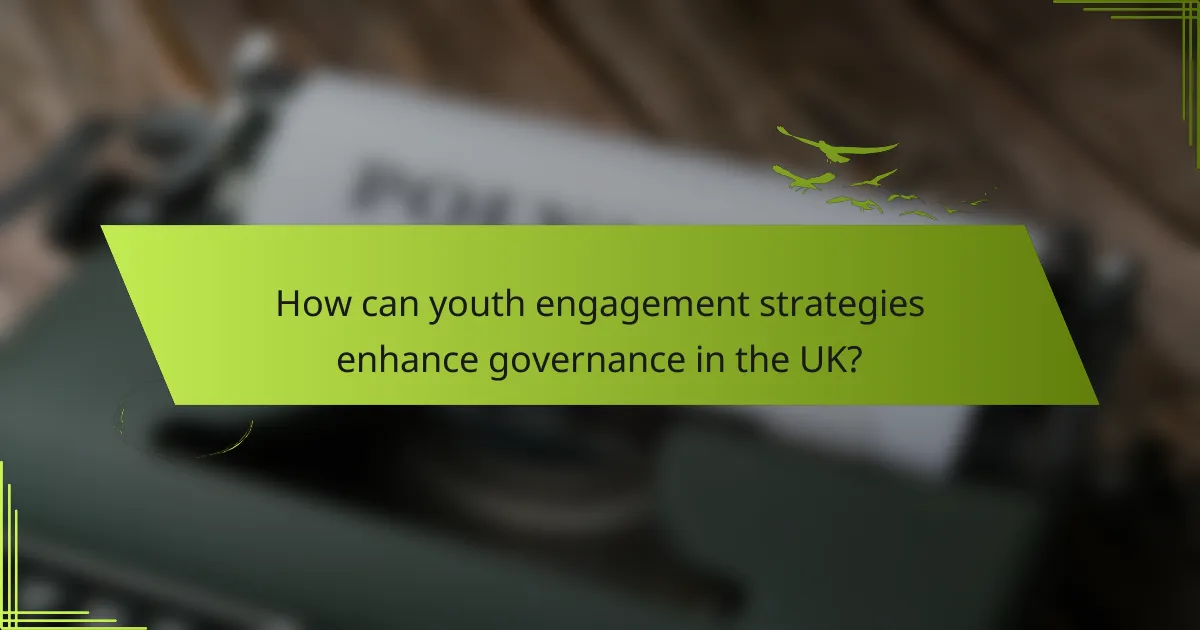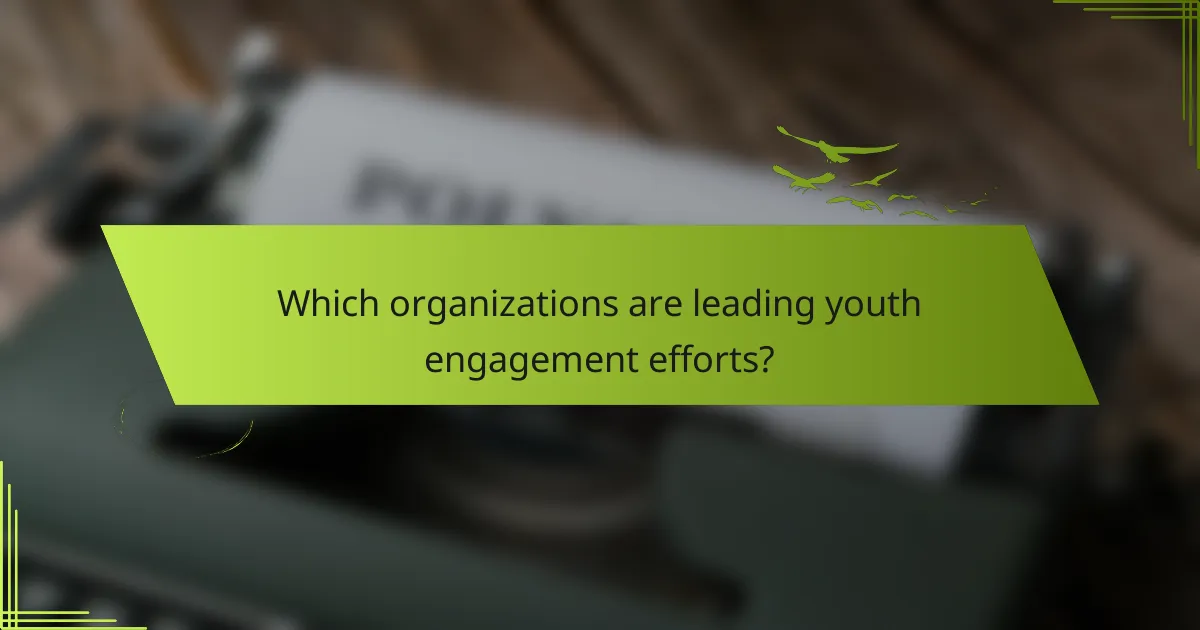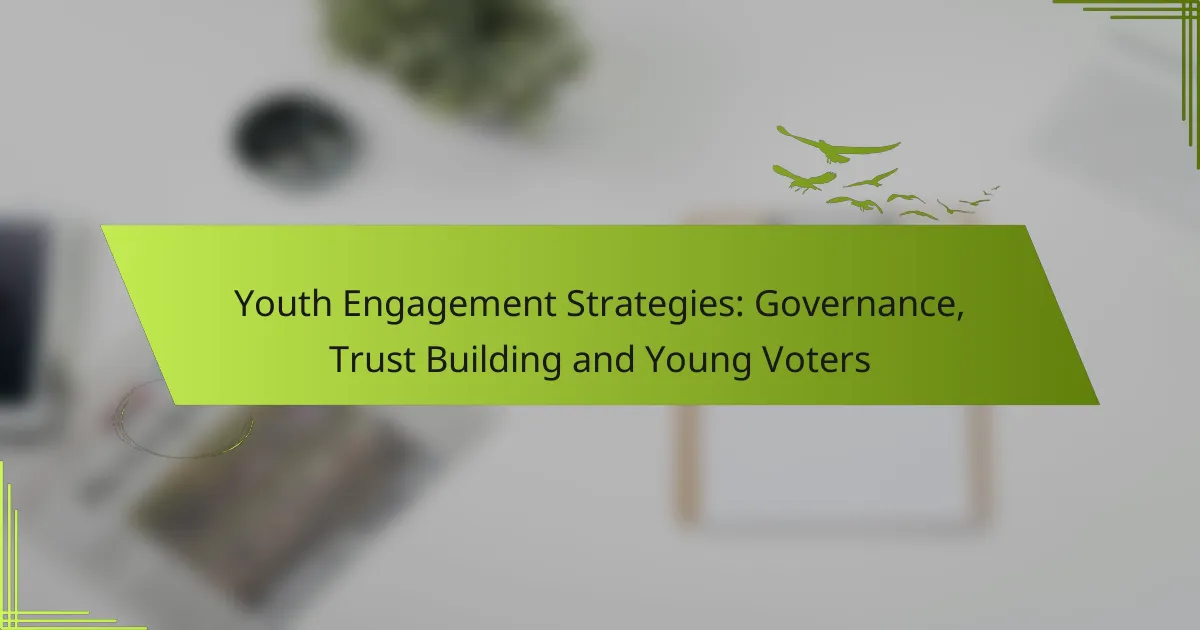Youth engagement strategies play a crucial role in enhancing governance by encouraging active participation and fostering trust between young people and decision-makers. By creating avenues for youth to influence policies that impact their lives, these strategies ensure that their voices are integral to the democratic process. Trust is vital for mobilizing young voters, as transparency and accountability in governance enhance their willingness to engage in elections and civic activities.

How can youth engagement strategies enhance governance in the UK?
Youth engagement strategies can significantly improve governance in the UK by fostering active participation and building trust between young people and decision-makers. These strategies create pathways for youth to influence policies that affect their lives, ensuring their voices are heard in the democratic process.
Increased participation in local councils
Encouraging young people to participate in local councils can lead to more representative decision-making. Initiatives such as youth council seats or advisory roles allow young individuals to express their views on community issues, which can enhance local governance. Local authorities may consider implementing outreach programs in schools to raise awareness about council activities and encourage youth involvement.
To maximize participation, councils should provide training and resources for young members, ensuring they understand governance processes. This could include workshops on public speaking, policy analysis, and community engagement techniques.
Implementation of youth advisory boards
Youth advisory boards serve as a direct link between young citizens and policymakers, offering insights on issues relevant to their demographic. These boards can be established within various governmental departments, allowing youth to contribute to discussions on education, health, and environmental policies. Regular meetings and open forums can facilitate ongoing dialogue and collaboration.
For effective advisory boards, it is crucial to ensure diversity in representation, including different backgrounds and perspectives. This can be achieved by actively recruiting members from various communities and providing incentives for participation, such as stipends or certificates of recognition.
Community-led initiatives
Community-led initiatives empower young people to take the lead in addressing local issues, fostering a sense of ownership and responsibility. Programs that support youth-led projects—such as environmental clean-ups, cultural events, or social campaigns—can enhance civic engagement and strengthen community ties. Local governments can support these initiatives through grants or logistical assistance.
To encourage successful community-led initiatives, it is essential to provide mentorship and resources. Partnering with local organizations can help young leaders gain the skills and knowledge necessary to implement their projects effectively, ensuring long-term sustainability and impact.

What role does trust building play in engaging young voters?
Trust building is essential for engaging young voters, as it fosters a sense of reliability and connection between them and the political system. When young people perceive transparency and accountability in governance, they are more likely to participate in elections and civic activities.
Transparency in decision-making
Transparency in decision-making involves openly sharing the processes and criteria that guide political choices. When young voters see that their opinions are valued and that decisions are made based on clear, accessible information, they are more inclined to trust the system.
Governments can enhance transparency by publishing meeting minutes, budgets, and policy drafts online. Regular updates on how public input influences decisions can further strengthen this trust.
Consistent communication channels
Establishing consistent communication channels is vital for maintaining engagement with young voters. Regular updates through social media, newsletters, and community forums help keep young people informed and involved in ongoing discussions.
Using platforms that resonate with younger audiences, such as Instagram or TikTok, can effectively convey messages and encourage interaction. Engaging content, such as polls or Q&A sessions, can also foster a two-way dialogue, enhancing trust.
Involvement in policy development
Involving young voters in policy development allows them to contribute their perspectives and priorities. This participation can take the form of youth advisory boards, public consultations, or workshops where young people can voice their concerns and suggestions.
By integrating youth input into policy-making, governments demonstrate their commitment to addressing the needs of younger generations. This collaborative approach not only builds trust but also empowers young voters to take ownership of their civic responsibilities.

Which organizations are leading youth engagement efforts?
Several organizations are at the forefront of youth engagement, focusing on governance, trust building, and mobilizing young voters. These groups implement strategies to empower youth, ensuring their voices are heard in political processes and community decision-making.
UK Youth
UK Youth is a national charity that champions young people, providing them with opportunities to engage in civic life. They offer programs that promote leadership skills and encourage youth participation in local governance. By collaborating with various organizations, UK Youth helps amplify the voices of young people across the UK.
Through initiatives like the “Youth Voice” program, UK Youth facilitates discussions that allow young people to express their opinions on key issues. This approach not only builds trust between youth and policymakers but also fosters a sense of community and responsibility among participants.
National Union of Students
The National Union of Students (NUS) represents millions of students across the UK, advocating for their rights and interests. NUS engages young voters by organizing campaigns that highlight the importance of voting and political participation. Their efforts aim to educate students on political issues that directly affect their lives.
NUS also provides resources and training for student leaders, empowering them to mobilize their peers effectively. By focusing on issues like tuition fees and mental health, NUS builds trust with young voters, encouraging them to take an active role in governance.
Young Scot
Young Scot is a national youth information and citizenship charity in Scotland that focuses on empowering young people through information and engagement. They provide resources that help young Scots understand their rights and responsibilities within the governance framework. This organization plays a crucial role in connecting youth with local decision-makers.
Through initiatives like the “Young Scot National Entitlement Card,” they offer practical benefits that encourage civic engagement. Young Scot also facilitates forums where young people can voice their opinions on local issues, fostering a culture of trust and participation in governance.

How can social media be utilized for youth engagement?
Social media serves as a powerful tool for engaging youth by fostering direct communication and creating interactive spaces. By leveraging popular platforms, organizations can effectively reach and mobilize young voters, enhancing their participation in governance.
Targeted campaigns on platforms like Instagram
Targeted campaigns on Instagram can significantly boost youth engagement by using visually appealing content that resonates with younger audiences. Brands and organizations can utilize targeted ads to reach specific demographics based on interests, location, and behaviors, ensuring that messages are seen by those most likely to engage.
For example, a campaign promoting voter registration could feature eye-catching graphics and relatable messaging that encourages young people to take action. Utilizing hashtags and engaging stories can further amplify reach and interaction.
Interactive polls and Q&A sessions
Interactive polls and Q&A sessions on platforms like Twitter and Instagram Stories allow youth to express their opinions and ask questions directly. These features create a two-way dialogue, making young voters feel heard and valued in the decision-making process.
For instance, organizations can host live Q&A sessions with local leaders or influencers to discuss pressing issues. Polls can gauge opinions on specific topics, providing valuable insights while also encouraging participation.
Influencer partnerships for outreach
Partnering with influencers who resonate with young audiences can enhance outreach efforts significantly. Influencers can authentically communicate messages about civic engagement, making them more relatable and impactful for their followers.
Organizations should identify influencers whose values align with their goals and collaborate on campaigns that promote voter registration or participation in local governance. This approach can leverage the influencer’s credibility and reach to engage a wider audience effectively.

What are effective methods for building trust with young voters?
Building trust with young voters involves consistent engagement, transparency, and creating opportunities for their voices to be heard. Effective methods include establishing regular feedback mechanisms, fostering collaborative community projects, and facilitating peer-led discussions.
Regular feedback mechanisms
Regular feedback mechanisms allow young voters to express their opinions and concerns, fostering a sense of inclusion. Tools such as online surveys, suggestion boxes, and social media polls can be effective in gathering insights and demonstrating responsiveness.
Consider implementing feedback loops where young voters can see how their input influences decisions. For example, sharing results from surveys and outlining actions taken based on feedback can enhance trust and engagement.
Collaborative community projects
Collaborative community projects engage young voters by involving them in initiatives that address local issues. These projects can range from environmental clean-ups to youth mentorship programs, allowing young people to contribute meaningfully while building connections with local governance.
When planning these projects, ensure they align with the interests and needs of the youth demographic. Partnering with local organizations can provide additional resources and credibility, making the projects more impactful and trustworthy.
Peer-led discussions and forums
Peer-led discussions and forums create safe spaces for young voters to share their views and experiences. These gatherings can be informal meet-ups or structured events, allowing for open dialogue on political issues that matter to them.
Encourage young leaders to facilitate these discussions, as they can relate better to their peers. Providing platforms for these conversations, such as community centers or online forums, can enhance participation and strengthen trust in governance.

What criteria should be considered for evaluating engagement strategies?
Evaluating engagement strategies requires a focus on measurable outcomes that reflect the effectiveness of youth participation. Key criteria include participation rates and the quality of feedback received from young voters, as these indicators reveal how well strategies resonate with the target demographic.
Participation rates
Participation rates indicate the level of youth involvement in governance activities, such as voting, town hall meetings, or community initiatives. High participation rates suggest that engagement strategies are effectively reaching and motivating young voters. Aim for at least 30-50% participation in local events to gauge success.
To improve participation rates, consider using social media campaigns, peer-to-peer outreach, and incentives like small rewards or recognition. Monitoring trends over time can help identify which strategies yield the best results and allow for adjustments as needed.
Feedback quality from youth
The quality of feedback from young voters is crucial for understanding their needs and preferences. Collecting detailed insights through surveys, focus groups, or informal discussions can provide valuable information on what resonates with this demographic. Aim for qualitative feedback that highlights specific concerns or suggestions.
To enhance feedback quality, ensure that questions are clear and relevant, and create a safe environment for open dialogue. Regularly review and act on the feedback received to demonstrate that youth voices are valued, which can further build trust and encourage ongoing engagement.
